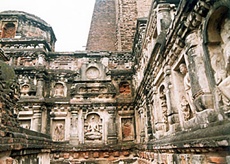Nalanda University back to life after 800 years
01 Sep 2014
India's first university, the 800-year-old Nalanda, is back to life with the resurrected centre of learning opening its doors to the world on Monday. The new international knowledge destination with seven schools planned for post-graduate and doctorate students is expected to be back in its full glory by 2020.
 The union government's department of expenditure has sanctioned Rs2,700 crore to raise Nalanda as a classical residential university with seven disciplines with a maximum strength of 20 each.
The union government's department of expenditure has sanctioned Rs2,700 crore to raise Nalanda as a classical residential university with seven disciplines with a maximum strength of 20 each.
The new university took off with only two schools - the school of ecology and environmental studies and the school of historical studies - 11 faculty members and 15 students that include five women.
The 15 were selected from around 1,000 applicants after multiple screening and tests. The admission process is still on as only 15, including three from Bihar, have joined in the two schools of the planned seven that started Monday.
The students also include a Bhutan university dean on study leave and a post-graduate in Buddhist Studies from Japan.
Economist Amartya Sen is the chairman of the governing body of the university, while renowned teachers from various countries are its members.
Former Singapore foreign minister George Yeo and ministry of external affairs secretary Anil Wadhwa are also part of the governing body.
While two of the faculty members are from abroad - Samuel Wright from the US and Yin Ker of Singapore - the Indian teachers too have experience of teaching at foreign universities. The university plans to stick to a faculty ratio of 1:8.
Set up under a 2010 special Act of Parliament, the university is being constructed on 455 acres of land at the Rajgir foothills.
For the present, however, the university will function from the Rajgir Convention Centre, a state government building.
Government-owned Tathagat Hotel will serve as the hostel.
The classes are expected to shift out of the Rajgir Convention Centre to a makeshift building in a month while construction work on its own campus is expected to start from February 2015.
The university has hired 40 rooms at the Tathagat Hotel for students and teachers. The five women students are lodged on a separate floor.
For vice chancellor Gopa Sabarwal, ''it was a dream come true'', and once it gets going, Sabarwal hopes to expand operations.
''Of the 11 teachers, seven have arrived. All teachers have outstanding careers. We hope to add schools of linguistics and literature, economics and management and also public health in a year.''
Elaborating on the university's plans, she said, the idea was to blend values of the ancient Nalanda University with the contemporary. Towards this, Nalanda has signed collaborations with a number of foreign universities, including Yale, she disclosed.
Among the five who opted for the School of Historical Studies is Shashi Ahlawat, a B.Tech from the Technological Institute of Textiles & Sciences, Bhiwani, Haryana. Despite her science background, a brush with competitive exams showed, ''I am cut out for excelling in history,'' she said.
Ngawang, the dean of historical research at Royal University of Bhutan, said there can't be a better place than Nalanda University to study history. ''Ever since the Bhutan government introduced Bhutan and Himalayan history in 2011, I had been thinking of studying history,'' he said.
Anshuman Shekhar quit his job at an IT firm to enroll at the School of Ecology and Environmental Studies. He had studied microbiology at Bharati Vidyapeeth University, Pune.
Akiro Nakamvva, a post-graduate from the University of Tokyo, will also be studying history at Nalanda University.
"More than a thousand students from various countries across the globe had applied for the seven schools on different subjects that will function at the university, of which only 15, including one each from Japan and Bhutan, were selected," said the VC.
The university on Sunday also completed the three-day orientation programme for the students.
Sabharwal said external affairs minister Sushma Swaraj would be visiting on 14 September. "We have decided to have a big function when Mrs Swaraj visits NU on September 14. By that time things will settle down and the media glare will also decrease to some extent," Sabharwal said.
The revival of ancient Nalanda University (NU), which once attracted students from the world over, also marks the fruition of the dream of former President APJ Abdul Kalam.
When President Kalam mooted NU, the Singapore government had also proposed the revival of the university having international character, but suitable to the modern times.
Former Bihar chief minister Nitish Kumar also showed a keen interest in it and the work on the concept began soon after.
The present NU campus will be about 12 km from the site of the ancient university, which began during the Gupta period in 6th century AD and came to an end after being ransacked, looted and burnt in 1193 AD by the invading Turk army led by Bakhtiyar Khilji.